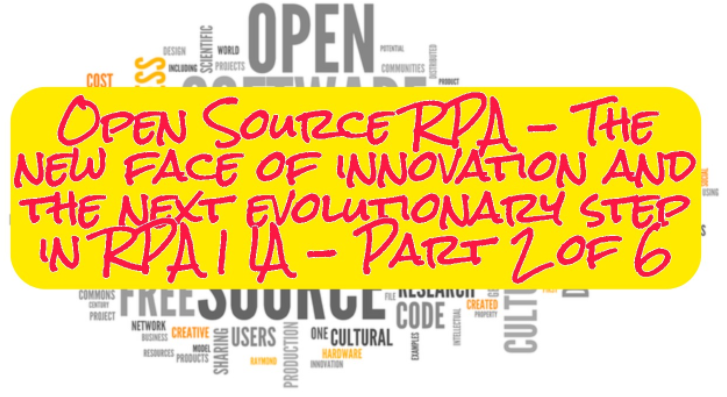22 ways to cut the cost of an automation program – Part 2 of 4
It is as critical to look after the bottom line as it is to look after the top line. There are multiple ways to cut the cost of an intelligent automation program including;
6. Use an online marketplace to buy services or crowd source business challenges: Web sites such as Guru, UpWork, CrowdAnalytix, DriveData.org, Freelancer.com, peopleperhour.com are online marketplaces for freelance services. These can deliver expectational value for money when compared to the expense of hiring full time staff. Need a new website, chatbot, analytics model, automation completed, AI/ML model or python code then look to marketplaces to connect with some of the very best talent at excellent prices.
“Online marketplaces and crowd sourced competition sites offer a plethora to options at very affordable prices. It is fair to say that these options come with an element of risk but you can find nuggets of gold that make these market places exceptionally good value.”
Harrison Goode, Intelligent Automation, AI and Emerging Technology Recruitment Specialist.

www.kaggle.com – crowd source analytics competition platform
7. Shared Risk of Outcome based model: Consultancies and system integrators are becoming more creative when engaging with organisations. Shared risk or outcome based models ensure vendors have ‘skin in the game’ where a straight consultancy cost of service model does not. Ask your consulting partner if they are willing to engage in a success based outcome model.
“For anyone interested in lowering upfront fees and putting the outcome well and truly into focus, the idea of gainshare holds any advantages, but doesn’t come without it’s potential risks (for both parties). For anyone with a need, but lacking in initial budget the alternative being “do nothing”, this is a great alternative.
Usually an in depth assessment would be completed by the implementation partner, to assess the rewards on offer and ensure the “gainshare” compensated them for the costs that a fixed fee implementation would have delivered in revenue (most of the time more) hence the risk on the client who could end up paying more in the long run.”
Wayne Butterfield, Automation Expert
8. Begin with an end in mind – Sounds simple? Sounds obvious right? The fact is, incumbents continue to run digital automation initiatives without tying them to their business strategy. This often leads to multiple fault lines and stress points which break automation programs (e.g. lack of commitment from the recipient business, lack of cohesion with ancillary departments, inadequate budgets, unreasonable timelines, frustrated stakeholders etc.). Begin with the end in mind. Align your organisation’s automation program to your business strategy from day one to save your organisation an expensive less in how not to automate.
Nitesh Rungta, Intelligent Automation Lead
9. Pareto it. Teams and groups fall into the trap of selecting easy / simple target processes to automate. Whilst it makes sense to automate the easy stuff, this also represent a business risk. Low value automations never excite an organisations leadership team to invest significant sums in automation programs. Businesses should focus on identifying and automating the 20% of business processes that offer 80% of the highest possible business value.
Nitesh Rungta, Intelligent Automation Lead

Pareto 80:20
10. Focus on reusable code. Automation programs should build reusable code libraries from the very start. However, many organisation do not focus on this at the beginning of their automation journeys. Code reusability should be high on every organisations agenda. This may mean that automations cost more and take longer to build at the start. However, organisations should expect to see automation velocity increase, and build costs decrease, over the longer term. Automation is a long term strategic play. Therefore, build for the long term not the short term.
“One of the key challenges seen in packaging up processes for automation and auctioning them off to the lowest bidder to develop, is a lack of standardised practices or re-useable code. If you don’t centrally govern or mandate re-usability across your delivery capabilities, you will not benefit from lowering your effort over the long term. Short term cost savings can cost you more in the long term through increased difficulty maintaining processes and not seeing your development cycles reduce over time.”
Wayne Butterfield, Automation Expert
Reward developers who focus on code reusability to instils the right behaviours in an automation team over the longer term. Nitesh Rungta, Intelligent Automation Lead
“Developers should modularise their code and create stand-alone components that can be reused several times over in various automation projects. Using reusable components helps accelerate development, quickens testing and allows for easier ode debugging, which translates into lower cost for an organisation.”
Nitin Kamra, Senior Manager RPA
“When it comes to RPA, documentation of implementations, best practices, and company standards are invaluable. Putting proper procedures in place for your developers to follow will make for an effective RPA program and greatly increase the chance of success. Best practices and standards will keep your team from reinventing the wheel and help create consistencies in the way the RPA team implements automated systems. Creating documentation for how to use and modify implementations of RPA as well as their associated systems will help new team members become productive earlier and remove the risk of losing expertise when an employee transfers to another department/leaves the company.”
William Roseberry, CEO
What other ways are there to cut the cost of an automation program?
#intelligentautomation #bots #rpaworks #digitaltransformation#roboticprocessautomation #rpa #cognitiveautomation #digitaldisruption#digitalworkforce #processautomation #digitalfuture #digitalstrategy
Other articles: If you like this article then you may find these articles of use too.
1. How to build a business case for Intelligent Automation and Robotic Process Automation
3. 8 questions to ask to ensure you select the ‘right’ processes to automate using RPA | IA.
4. 14 rules for Robotic Process Automation (RPA) and Intelligent Automation (AI) success
5. The A-Z of Robotic Process Automation, Intelligent Automation and Digital Transformation
6. The biggest lie told to RPA customers – 50 robots equals success
7. 40 essential selection criteria to choose an RPA platform
If this could benefit someone else tag them and share this.
Free to reuse: We are a community of RPA and Intelligent Automation experts with years of real world experience. We have stories to tell and the scars to show for it. We share our collective wisdom for free to simply provide as much value as we can to you. Therefore, if you want to post this article on your LinkedIn page then please feel free to do so. The more information we share within the RPA community the more likely businesses are to succeed with this excellent technology.
Further Help: If I can help you in any way please do reach out.
Note: The views expressed above are our views and not those of my employer or the employers of the contributing experts.









Leave a Reply